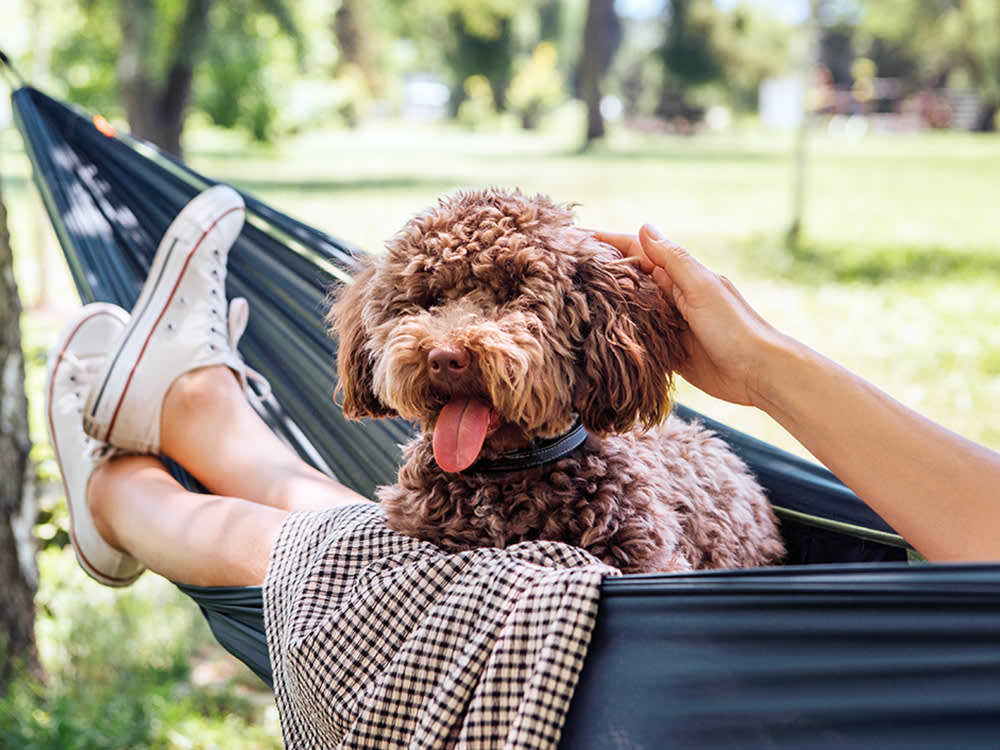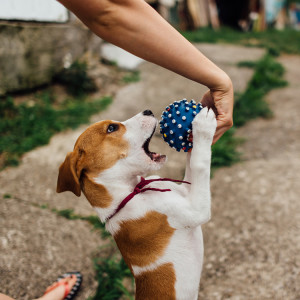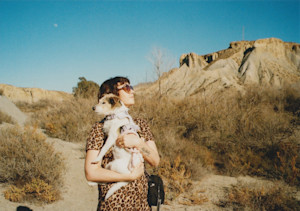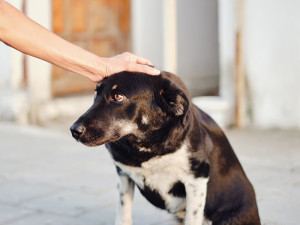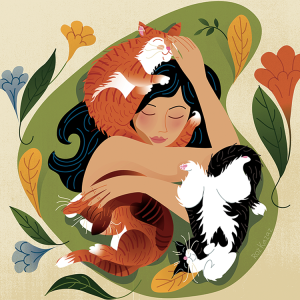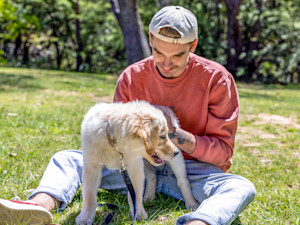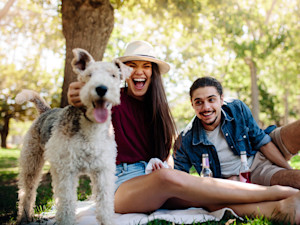4 Reasons Dogs Like Being Pet
It’s good for them, and it’s good for you. Here’s why everyone wins.
In This Article:
The Science Behind Petting Why Dogs Like Being Petted How to Pet a Dog How to Tell When a Dog Doesn't Want Pets What to Do When a Dog Does Not Want to Be Petted How to Build a Stronger Bond With Your Dog
Petting a dog is one of the best things we can do for our mental health. It can actually lower the stress hormone (cortisol) and release the love hormone (oxytocin), creating a better mood and overall feeling of mental wellbeing. But part of what makes petting a dog feel so good is that they like it, too. This is actually unusual in the animal kingdom — many other animals don’t like being touched by humans. Many dogs even have their own unique ways of asking for pets: They may lick you, pat you, or nuzzle you.
So, why exactly does your dog like to be pet so much? There are lots of different reasons, but a big one is that it releases the same chemicals in them that we get from petting them. So when you cuddle with your pet, there’s a reciprocal cycle of love hormones going back and forth, strengthening your bond and relaxing both of you.
Trick question: All dogs are perfect! But find out which type is the best fit for you.
How much do you spend on your pet per year?
The science behind why dogs like to be petted
What dogs feel and how they react when they’re petted is all about instincts, but there is some science going on there, too. Being petted by a human lowers a dog’s stress hormone, cortisol, and increases their happy hormone, oxytocin. So the more you pet your dog, the more your bond increases.
Additionally, your dog’s body is full of nerve endings. Spots such as their ears and back are packed with nerves that feel good when touched, which is why you may notice your dog going crazy when they’re touched in these places. Physiologically, being pet simply makes your dog feel happy and closer to you.
Why dogs like being petted
Dogs love to be petted, but why? We break down the main reasons why dogs love touch.
It feels good.
Dogs’ bodies aren’t that different from ours. They have tons of nerve endings in their bodies, particularly in places like their ears. That means that being petted feels good and sends happy signals all over their body. It can also provide sensory stimulation and relieve negative sensations, such as itching and pain. Because dogs can’t reach all the places they want to, scratches in spots such as the back of their necks can relieve discomfort that they’ve been struggling to get to.
It reminds them of their mother.
When your dog was a puppy and still being looked after by their mother, she would lick them and groom them. The way that you touch and pet your dog will remind them of those early memories of being with their mother. This makes them feel comforted and safe.
It releases positive chemicals.
When we pet dogs, it releases positive chemicals in them, such as oxytocin, and reduces negative ones, such as cortisol. Those positive chemicals help reduce feelings of stress, making your dog feel calm, happy, and relaxed.
It strengthens bonding.
Dogs are pack animals, and you are a very special member of their pack. Just as the love hormone (oxytocin) helps increase feelings of bonding between people, it can do the same thing across species. When it’s released, it makes your dog feel bonded to you, which increases with the frequency of petting.
How to pet a dog
If you’re petting a dog for the first time, the most important thing you can do is ask their pet parent if it’s OK. The pet parent can tell you exactly how to best approach that particular dog. As a general guideline, you can reach out your hand and let them sniff it. If they seem to be comfortable with that, try scratching them under their chin or on their chest. Never approach a dog you don’t know from over their head, and never touch their belly unless they make it absolutely clear that they’re comfortable with it. Always consider a dog’s boundaries and listen to their signals.
How to tell when a dog doesn’t want pets
If a dog doesn’t want to be petted, they will let you know. If they are seriously against it, they may growl or snap at you as you reach out your hand. In that case, withdraw immediately and don’t try again.
They may offer you more subtle signs, as well. Some dogs may shy away from your hand or start trembling. Others may just walk away. A rescue dog may have been through trauma and have a number of reasons why they don’t want your hands on them. If this happens, just be patient and only do what they seem to be comfortable with.
What to do when a dog does not want to be petted
If a dog doesn’t want to be petted, respect their boundaries and back away. If they are your dog, however, you may need to work with a trainer or behaviorist to pet them in a way that they’re comfortable with on their time. You should never rush it or do anything in the moment that they’re not happy with. But to have a strong relationship, you should try to get to a point where you can pet them without them pulling away or getting upset.
How to build a stronger bond with your dog through petting
For most of us, petting our dog is instinctive: It’s just something we do every single day because we want to. However, life gets in the way, and sometimes we may not pet our dog as much as we should. By setting aside time every day to cuddle with your pet, you can build stronger bonds and strengthen your relationship.
Bottom line
Dogs love to be petted, particularly by their favorite person, because it feels good. It releases happy hormones that increase bonding with their pet parent, and makes them calm. Additionally, you’re rubbing nerve endings, which relaxes the dog.
FAQs
Where shouldn’t you pet a dog?
There are no hard-and-fast rules on where you shouldn’t pet a dog. Some dogs like being touched in places that others might totally hate. That being said, you should always go slowly before petting them somewhere more sensitive, like on their belly. Many dogs dislike being touched on their nose, paws, and tail, so always take it easy and don’t touch them in sensitive places without “asking” first.
Does petting help dogs relax?
Being pet helps dogs relax. It releases feel-good chemicals (such as oxytocin) in their bodies and makes them feel at ease. Of course, if being pet doesn’t seem to relax a dog, pay attention to their signals and don’t do anything that they’re not comfortable with.
Is there a difference between petting and massaging a dog?
If you and your dog have a strong bond, and you want to take petting further, try giving them a massage. There is a difference between petting and massaging, which comes with additional benefits. A massage, when done right, can aid healing and mobility, easing pain, particularly in older dogs or those with joint issues. Make sure you ask your vet about how to do it right.
Why do dogs crave petting?
Dogs crave petting for lots of different reasons. It feels good. It strengthens their bond with you. And it releases chemicals that make them feel relaxed and happy. Although some dogs might not like to be petted, if yours does, the main reason is that you’re making them feel good. And that’s something to be proud of.
